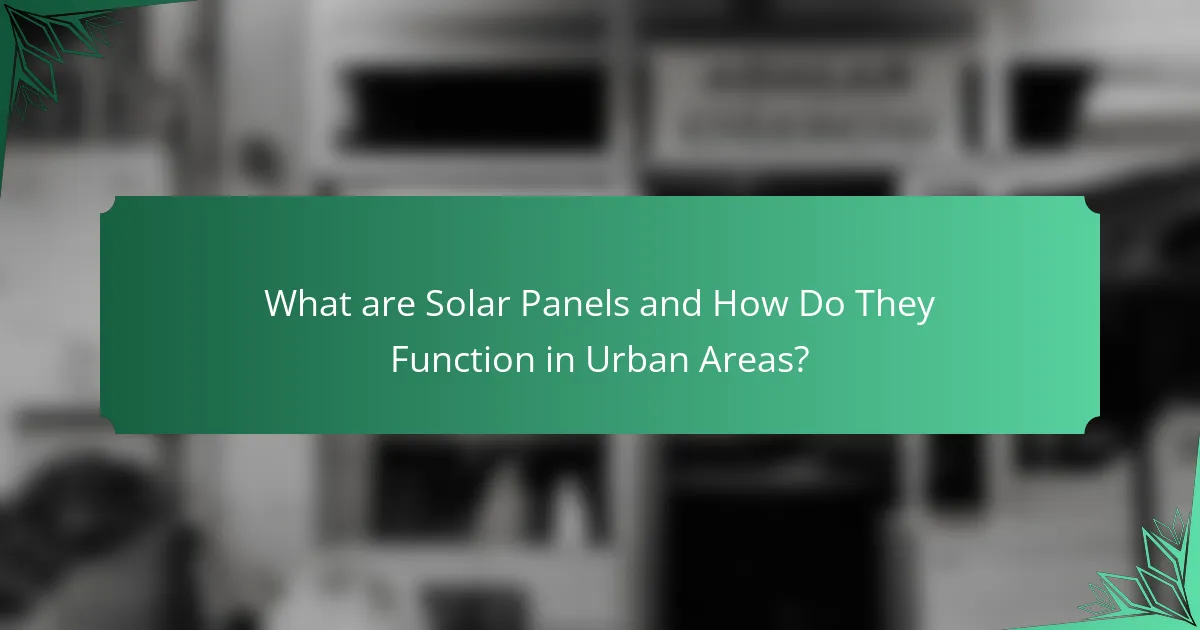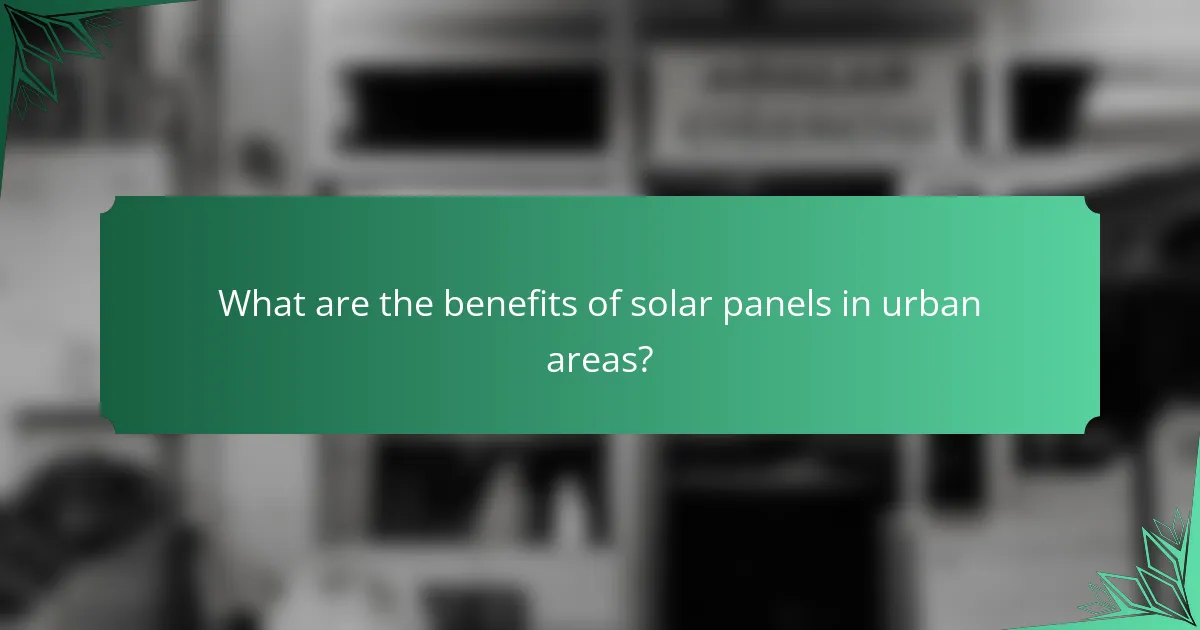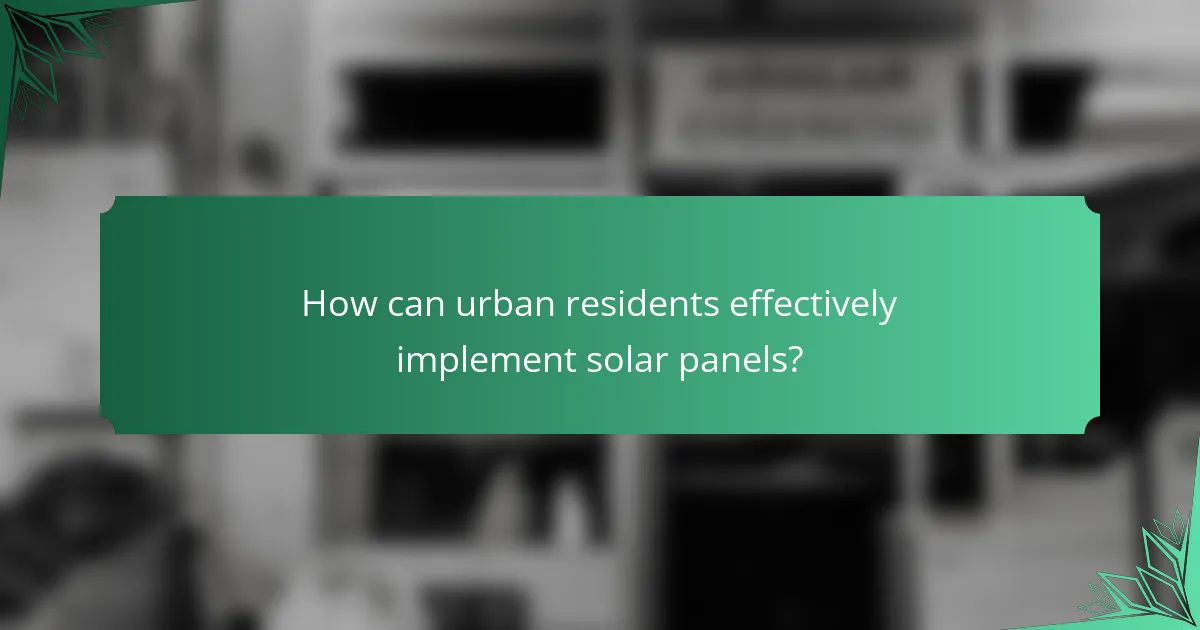
What are Solar Panels and How Do They Function in Urban Areas?
Solar panels are devices that convert sunlight into electricity. They function through photovoltaic cells that absorb solar energy. In urban areas, solar panels are often installed on rooftops or integrated into building designs. This maximizes space usage and harnesses sunlight effectively. Urban environments may pose challenges such as shading from tall buildings. However, advancements in solar technology allow for better performance in low-light conditions. Additionally, urban solar installations can reduce energy costs and lower carbon footprints. According to the U.S. Department of Energy, urban solar capacity has increased significantly, demonstrating their growing role in sustainable energy solutions.
How do solar panels convert sunlight into electricity?
Solar panels convert sunlight into electricity through the photovoltaic effect. When sunlight hits the solar cells, it excites electrons in the semiconductor material. This movement of electrons generates direct current (DC) electricity. The solar cells are typically made of silicon, which is a common semiconductor.
The generated DC electricity is then converted to alternating current (AC) electricity using an inverter. AC electricity is the form used in homes and businesses. Solar panels can produce electricity even on cloudy days, though efficiency may be reduced.
According to the U.S. Department of Energy, solar panels can convert 15% to 20% of sunlight into usable electricity. This process contributes significantly to renewable energy generation.
What are the key components of solar panels?
The key components of solar panels are photovoltaic cells, a backing material, a protective glass layer, an encapsulant, and a frame. Photovoltaic cells convert sunlight into electricity. The backing material supports the cells and provides insulation. The protective glass layer shields the cells from environmental damage. The encapsulant secures the cells and protects them from moisture. The frame offers structural support and facilitates installation. These components work together to enhance the efficiency and durability of solar panels.
How does urban sunlight exposure impact solar panel efficiency?
Urban sunlight exposure significantly impacts solar panel efficiency. In urban areas, buildings and other structures often create shading. This shading reduces the amount of direct sunlight reaching the solar panels. Studies indicate that even partial shading can lead to a decrease in energy output by up to 50%. Dust and pollution accumulation on panels in cities can also obstruct sunlight. Regular cleaning can mitigate this issue and enhance efficiency. Moreover, the angle of solar panels can be affected by surrounding structures. Proper installation can optimize exposure to sunlight, improving overall performance.
What challenges do solar panels face in urban environments?
Solar panels face several challenges in urban environments. Limited roof space restricts installation opportunities. High building density can lead to shading from nearby structures. Urban pollution may reduce solar panel efficiency. Additionally, regulations and permitting can complicate installation processes. Maintenance access is often more difficult in crowded areas. Aesthetic concerns may lead to resistance from residents or city planners. Finally, the high cost of installation can deter investment in solar technology.
How does limited space affect solar panel installation?
Limited space significantly impacts solar panel installation by restricting the number of panels that can be placed. In urban areas, rooftops often have limited square footage. This can lead to reduced energy generation capacity. Fewer panels mean less electricity produced, which affects overall efficiency. Additionally, limited space may necessitate the use of higher-efficiency panels. These panels can capture more sunlight in smaller areas. However, they often come at a higher cost. Furthermore, limited installation space can complicate panel orientation and angle. Proper orientation is crucial for maximizing sunlight exposure. Overall, limited space presents unique challenges for solar panel installation in urban settings.
What are the impacts of building regulations on solar panel deployment?
Building regulations significantly impact solar panel deployment. These regulations can either facilitate or hinder the installation of solar systems. For instance, strict height restrictions may limit the placement of solar panels on rooftops. Additionally, aesthetic guidelines can restrict the visibility of solar installations. Some regulations may require permits that increase installation costs and time. Conversely, supportive regulations can incentivize solar adoption through tax credits or streamlined permitting processes. For example, the U.S. Solar Investment Tax Credit has spurred growth in solar installations. Overall, building regulations play a crucial role in determining the feasibility and attractiveness of solar panel deployment.
How do shading and nearby structures influence solar panel performance?
Shading and nearby structures significantly reduce solar panel performance. Shading can occur from trees, buildings, or other obstacles. When panels are shaded, their energy output decreases. Studies show that even partial shading can cause a drop in efficiency by up to 50%. Nearby structures can also affect the angle of sunlight. An optimal angle is crucial for maximum energy absorption. In urban areas, this is often compromised. The positioning of solar panels must consider potential shading sources. Proper site assessment can mitigate these issues.
What solutions exist to overcome the challenges of solar panels in cities?
Solutions to overcome the challenges of solar panels in cities include innovative design, policy support, and community engagement. Innovative designs, such as building-integrated photovoltaics, allow solar panels to blend with architecture. Policy support can provide incentives and streamline permitting processes for solar installations. Community engagement fosters public awareness and acceptance of solar energy. Additionally, energy storage solutions can address intermittency issues, ensuring a reliable power supply. Research shows that cities implementing these strategies see increased solar adoption rates. For example, San Diego’s solar policies have led to a significant rise in installations, demonstrating the effectiveness of supportive measures.
What innovative installation techniques can maximize space efficiency?
Innovative installation techniques that can maximize space efficiency for solar panels include vertical installations, building-integrated photovoltaics (BIPV), and solar canopies. Vertical installations utilize walls or facades, which are often underused spaces. BIPV incorporates solar panels directly into building materials, such as windows or roofs, optimizing surface area. Solar canopies provide shade while generating energy in parking lots or outdoor spaces. These techniques allow for better utilization of limited urban space. Research indicates that BIPV can increase energy generation by 30% in densely populated areas (Source: “Building-Integrated Photovoltaics: A Comprehensive Review,” Renewable Energy, Authors: A. S. Sinha et al.).
How can urban planning integrate solar energy solutions?
Urban planning can integrate solar energy solutions by incorporating solar infrastructure into building designs and urban layouts. This includes mandating solar panels on new constructions and retrofitting existing buildings. Zoning regulations can be adjusted to encourage solar installations in residential and commercial areas. Additionally, urban planners can design public spaces with solar canopies and shading structures. Incentives for solar energy adoption can be provided through tax breaks or grants. Collaborations with utility companies can facilitate solar energy integration into the grid. Studies show that cities implementing such strategies can significantly increase solar energy usage, enhancing sustainability and reducing carbon footprints.

What are the benefits of solar panels in urban areas?
Solar panels in urban areas provide significant benefits. They reduce electricity costs for homeowners and businesses. Studies show that solar energy can lower utility bills by up to 50%. Solar panels also contribute to environmental sustainability. They decrease reliance on fossil fuels and reduce greenhouse gas emissions. Urban areas often have limited green space. Solar panels utilize rooftops effectively, maximizing land use. Additionally, solar installations can increase property values. Homes with solar energy systems sell for approximately 4% more than those without. Finally, solar panels promote energy independence. They allow urban residents to generate their own power, enhancing grid resilience.
How do solar panels contribute to energy sustainability in cities?
Solar panels contribute to energy sustainability in cities by harnessing renewable energy from the sun. This reduces reliance on fossil fuels, which are finite and polluting. Solar energy systems can be installed on rooftops and vacant land, maximizing urban space. They generate electricity that can power homes and businesses, decreasing greenhouse gas emissions. According to the Solar Energy Industries Association, solar power can offset approximately 90 million metric tons of carbon dioxide annually in the U.S. alone. Furthermore, solar panels can lower energy costs for consumers, promoting economic sustainability. They also create local jobs in installation and maintenance, boosting the urban economy. Overall, solar panels play a crucial role in creating a sustainable energy future for cities.
What environmental benefits do urban solar panels provide?
Urban solar panels provide significant environmental benefits. They reduce greenhouse gas emissions by generating clean energy. Solar panels can decrease reliance on fossil fuels. This shift helps mitigate climate change effects. Additionally, they improve air quality by lowering pollutants. Urban solar installations can also reduce urban heat islands. This leads to cooler city environments. Furthermore, solar panels contribute to biodiversity by promoting green roofs. They can support local wildlife habitats. Overall, urban solar panels play a crucial role in sustainable urban development.
How do solar panels impact local economies?
Solar panels positively impact local economies by creating jobs and generating revenue. The installation and maintenance of solar panels require skilled labor, leading to job creation in the renewable energy sector. According to the Solar Foundation’s National Solar Jobs Census, the solar industry employed over 250,000 workers in the U.S. in 2019.
Additionally, solar panels can reduce energy costs for residents and businesses. Lower energy bills can increase disposable income, boosting local spending. Communities with solar installations often see an increase in property values. A study by the Lawrence Berkeley National Laboratory found that homes with solar panels sold for about 4% more than comparable homes without them.
Solar projects can also attract investments and stimulate local economies. Local governments benefit from increased tax revenues from solar installations. These revenues can be used for public services and infrastructure improvements. Overall, solar panels contribute significantly to economic growth and stability in local communities.
What are the social benefits of solar panels in urban communities?
Solar panels in urban communities provide significant social benefits. They enhance energy independence by reducing reliance on external energy sources. This leads to lower energy costs for residents, improving economic stability. Solar panels also create job opportunities in installation and maintenance, contributing to local employment. They promote environmental awareness and sustainability among community members. Solar energy reduces air pollution, improving public health in densely populated areas. Furthermore, solar panels can increase property values, benefiting homeowners. Community solar projects foster collaboration among residents, strengthening social ties.
How can solar panels improve energy access for low-income households?
Solar panels can significantly improve energy access for low-income households by providing a reliable and affordable energy source. They reduce reliance on expensive grid electricity and fossil fuels. Many low-income areas face energy poverty, limiting access to essential services. Solar energy can lower energy bills, allowing families to allocate funds to other necessities.
Furthermore, solar panels can be installed in various settings, including rooftops and community spaces. This flexibility makes them accessible even in densely populated urban areas. According to the International Renewable Energy Agency (IRENA), solar energy can reduce energy costs by up to 90%.
Additionally, solar programs often include financing options, making it easier for low-income households to adopt this technology. Community solar projects allow multiple households to benefit from a shared solar installation. These initiatives can empower communities and enhance energy independence.
What role do solar panels play in community engagement and awareness?
Solar panels enhance community engagement and awareness by promoting sustainability and renewable energy education. They serve as visible symbols of commitment to environmental responsibility. Community members often participate in discussions and initiatives related to solar energy adoption. Local installations can lead to increased public interest in energy conservation practices. Educational programs and workshops often accompany solar panel projects, informing residents about their benefits. Studies show that communities with solar initiatives report higher levels of environmental awareness. For instance, a report by the National Renewable Energy Laboratory highlights increased community participation in sustainability efforts linked to solar projects.

How can urban residents effectively implement solar panels?
Urban residents can effectively implement solar panels by assessing their roof space and orientation. They should ensure that their roofs receive adequate sunlight throughout the day. Conducting a shading analysis helps identify potential obstructions. Residents must also check local regulations and zoning laws regarding solar installations.
Choosing the right type of solar panel is crucial. High-efficiency panels are ideal for limited space. Engaging with a reputable solar installer ensures proper installation and compliance with safety standards. Additionally, exploring financing options can make solar panel installation more affordable.
Residents can also consider community solar programs if individual installation is not feasible. These programs allow multiple households to benefit from a shared solar array. Lastly, monitoring energy production can help optimize the system’s performance over time.
What steps should individuals take to install solar panels in their homes?
Individuals should take the following steps to install solar panels in their homes. First, assess your home’s solar potential. This involves evaluating roof orientation, shading, and available space. Next, research local regulations and permits required for solar installation. Understanding these requirements is crucial for compliance. Then, choose the right solar panel system based on energy needs and budget. Consider factors such as efficiency and warranty. Following that, obtain quotes from multiple solar installers. Comparing prices and services helps in making an informed decision. After selecting an installer, schedule a site assessment. This allows the installer to finalize system design and installation specifics. Finally, monitor the installation process to ensure quality and adherence to plans. Regular monitoring also helps in understanding system performance post-installation.
How can homeowners assess their property for solar panel suitability?
Homeowners can assess their property for solar panel suitability by evaluating several key factors. First, they should analyze the roof’s orientation and angle. South-facing roofs typically receive the most sunlight. Next, homeowners need to check for shading from trees or nearby buildings. Significant shade can reduce solar panel efficiency.
Additionally, the roof’s condition is crucial. A structurally sound roof is necessary for solar panel installation. Homeowners should also consider the size of the roof. Sufficient space is required to accommodate the desired number of panels.
Local regulations and zoning laws should be reviewed. Some areas have specific guidelines for solar installations. Finally, homeowners can consult with solar energy professionals for a site assessment. These experts can provide tailored recommendations based on the property’s unique characteristics.
What financing options are available for urban solar panel installations?
Urban solar panel installations can be financed through various options. These include federal tax credits, which provide a 26% credit on installation costs until 2022, reducing financial burden. State incentives may also be available, offering rebates or additional tax credits. Solar loans are another option, allowing homeowners to borrow funds specifically for installation. These loans often have competitive interest rates and flexible terms. Leasing solar panels can be a viable choice, where homeowners pay a monthly fee without upfront costs. Power purchase agreements (PPAs) allow users to pay for the power generated rather than the panels themselves. Additionally, community solar programs enable shared investment in solar projects, making it accessible for those unable to install panels on their property. These financing options collectively enhance the affordability of urban solar panel installations.
What are the best practices for maintaining solar panels in urban settings?
Regular cleaning is essential for maintaining solar panels in urban settings. Dirt, dust, and debris can accumulate on the surface, reducing efficiency. Use a soft brush or sponge with mild soap and water for cleaning. This method prevents scratches and damage to the panels. Schedule cleaning sessions every six months or after significant weather events. Inspect the panels for any physical damage during cleaning. Look for cracks or loose connections that may affect performance. Ensure the surrounding area is free from overhanging branches that can block sunlight. Monitor the system’s performance regularly using monitoring tools. This helps identify any drops in efficiency promptly. Following these practices can significantly extend the lifespan and performance of solar panels in urban environments.
How can urban dwellers ensure optimal performance of their solar panels?
Urban dwellers can ensure optimal performance of their solar panels by maintaining cleanliness and ensuring proper orientation. Regularly cleaning the panels removes dust and debris, which can block sunlight. Studies show that dirty panels can lose 20% of their efficiency. Additionally, panels should be installed at an angle that maximizes sun exposure throughout the day. Urban dwellers must also monitor shading from nearby buildings or trees. Shading can significantly reduce energy output. Using monitoring systems can help track performance and identify issues early. Regular maintenance checks by professionals can also enhance efficiency and longevity.
What common issues should urban solar panel users be aware of?
Urban solar panel users should be aware of several common issues. Limited roof space can restrict the number of panels that can be installed. Shading from nearby buildings or trees can reduce solar efficiency. Local regulations may impose restrictions on installations, affecting design choices. Aesthetics can be a concern for homeowners and neighborhoods. Additionally, maintenance access can be challenging in densely populated areas. Urban pollution can also impact panel performance over time. Lastly, energy storage solutions may be necessary for optimal energy use, leading to additional costs.
Solar panels are devices designed to convert sunlight into electricity, utilizing photovoltaic cells. This article examines the challenges, solutions, and benefits of solar panel installations in urban areas, highlighting issues such as shading from buildings, limited roof space, and regulatory hurdles. It discusses how advancements in technology and innovative installation techniques can enhance efficiency and maximize space utilization. Additionally, the article outlines the economic, environmental, and social benefits of solar energy, including cost savings, reduced carbon footprints, and improved energy access for low-income households.